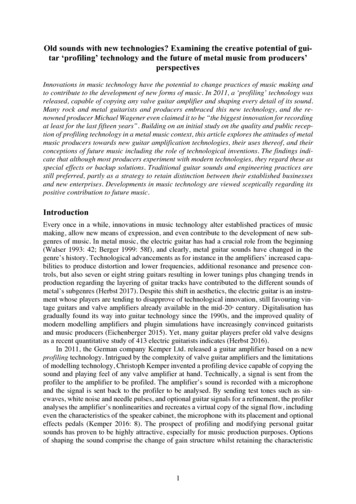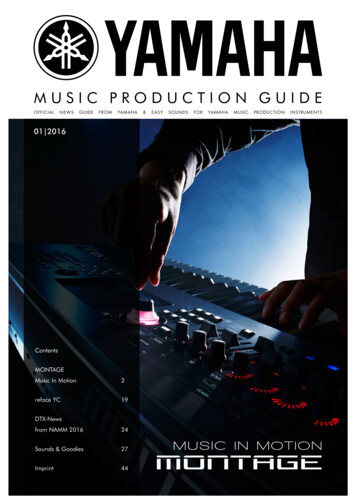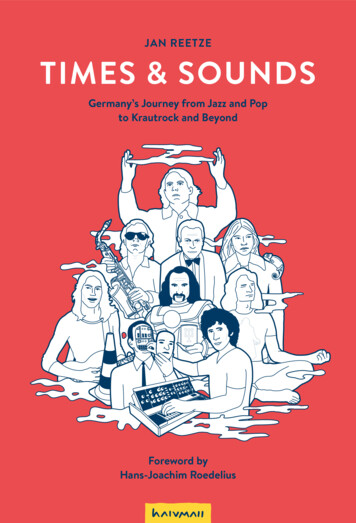
Transcription
Old sounds with new technologies? Examining the creative potential of guitar ‘profiling’ technology and the future of metal music from producers’perspectivesInnovations in music technology have the potential to change practices of music making andto contribute to the development of new forms of music. In 2011, a ‘profiling’ technology wasreleased, capable of copying any valve guitar amplifier and shaping every detail of its sound.Many rock and metal guitarists and producers embraced this new technology, and the renowned producer Michael Wagener even claimed it to be “the biggest innovation for recordingat least for the last fifteen years”. Building on an initial study on the quality and public reception of profiling technology in a metal music context, this article explores the attitudes of metalmusic producers towards new guitar amplification technologies, their uses thereof, and theirconceptions of future music including the role of technological inventions. The findings indicate that although most producers experiment with modern technologies, they regard these asspecial effects or backup solutions. Traditional guitar sounds and engineering practices arestill preferred, partly as a strategy to retain distinction between their established businessesand new enterprises. Developments in music technology are viewed sceptically regarding itspositive contribution to future music.IntroductionEvery once in a while, innovations in music technology alter established practices of musicmaking, allow new means of expression, and even contribute to the development of new subgenres of music. In metal music, the electric guitar has had a crucial role from the beginning(Walser 1993: 42; Berger 1999: 58f), and clearly, metal guitar sounds have changed in thegenre’s history. Technological advancements as for instance in the amplifiers’ increased capabilities to produce distortion and lower frequencies, additional resonance and presence controls, but also seven or eight string guitars resulting in lower tunings plus changing trends inproduction regarding the layering of guitar tracks have contributed to the different sounds ofmetal’s subgenres (Herbst 2017). Despite this shift in aesthetics, the electric guitar is an instrument whose players are tending to disapprove of technological innovation, still favouring vintage guitars and valve amplifiers already available in the mid-20 century. Digitalisation hasgradually found its way into guitar technology since the 1990s, and the improved quality ofmodern modelling amplifiers and plugin simulations have increasingly convinced guitaristsand music producers (Eichenberger 2015). Yet, many guitar players prefer old valve designsas a recent quantitative study of 413 electric guitarists indicates (Herbst 2016).In 2011, the German company Kemper Ltd. released a guitar amplifier based on a newprofiling technology. Intrigued by the complexity of valve guitar amplifiers and the limitationsof modelling technology, Christoph Kemper invented a profiling device capable of copying thesound and playing feel of any valve amplifier at hand. Technically, a signal is sent from theprofiler to the amplifier to be profiled. The amplifier’s sound is recorded with a microphoneand the signal is sent back to the profiler to be analysed. By sending test tones such as sinewaves, white noise and needle pulses, and optional guitar signals for a refinement, the profileranalyses the amplifier’s nonlinearities and recreates a virtual copy of the signal flow, includingeven the characteristics of the speaker cabinet, the microphone with its placement and optionaleffects pedals (Kemper 2016: 8). The prospect of profiling and modifying personal guitarsounds has proven to be highly attractive, especially for music production purposes. Optionsof shaping the sound comprise the change of gain structure whilst retaining the characteristicth1i
amplifier features, the effective equalisation at the sound source and the modification of transient characteristics by altering the picking sound as well as setting the overall resolution important for the perceptibility of individual notes in a chord. Furthermore, a layering functionallows the merging of sounds, produced by different amplifier sounds, cabinets, speakers andmicrophone positions, into a new sound not possible with just one guitar and amplifier. Leadingrock and metal producers thus have praised the profiling technology. Andy Sneap (2012: 5:40)predicted profiling technology to “move recording forward the same way as Pro Tools has”and Wagener (2013: 6:40f) concluded that it was “the biggest innovation for recording at leastfor the last fifteen years”.Surprisingly, the huge impact of profiling technology on musical practice has not stirredan academic debate so far. Only one study by Herbst, Czedik-Eysenberg and Reuter (2018) hasrecently explored this technology in a metal music studies context. With an experimental design, the study confirmed the high quality of profiled guitar sounds. Moreover, qualitative analyses of online discussion boards and magazine reviews indicated that music producers, in contrast to guitar players, might not merely see the benefit of profiling in the capability of copyingsounds. Prospects rather arise from transforming a vintage amplifier into a high-gain device,shaping the signal’s envelope without any natural counterpart, combining and layering soundsof various preamplifiers, power amplifiers, cabinets and miking choices plus a large selectionof digital effects. All this has the potential of creating sounds unheard of before. In the everlasting quest for greater heaviness (Berger & Fales 2005; Mynett 2013, 2017; Herbst 2017,2018) or for developing new subgenres of metal, such sounds could be beneficial.This article builds on the initial study by interviewing four internationally active professional German metal music producers. Producers rather than musicians were approached bothto add to the guitar players’ views described in the initial study and to locate the context of theresearch to the music studio. This research shares Bates’ (2012) understanding of recordingstudios as “meeting places, as container technologies, as a system of constraints on vision,sound and mobility, and as typologies that facilitate particular interactions between humansand nonhuman objects while structuring and maintaining power relations”. The studio is a placeof intense interaction between the producer, the musicians, recording and performing technologies, where current attitudes and practices come to light and might be challenged. FollowingAuvinen’s (2016: 10) techno-cultural perspective of music production, technologies are understood as “systems complexly bound up with surrounding cultural practices and as systems thatare shaping cultural meanings of music”. The recording studio thus is an important place wherecultural changes of future music are likely to happen, even before they are made available tothe audience on a live stage or as a released audio product.In this research project, profiling technology served as a starting point for investigatingmusical change through technological development. The interviews aimed at exploring theproducers’ personal views and practices, regarding both current engineering approaches of theguitar and more general deliberations on the future of metal music including the role of musictechnology. In addition to the producers, the inventor of profiling technology and CEO ofKemper Ltd., Christoph Kemper, was interviewed. He also gave insights into the use of thistechnology and presented his views as an inventor about future technological and musical developments. Against this backdrop, the present study was guided by the following researchquestions: What are metal music producers’ attitudes towards new guitar amplification technologies? How do they use profiling and related digital technology? How do producers andmusic instruments developers imagine the role of music technological inventions for futuremetal music? Based on the initial study (Herbst, Czedik-Eysenberg & Reuter 2018), researchon guitar players (Herbst 2016) and metal music production (Mynett 2013; Williams 2015;Herbst 2017), it was assumed that producers are more interested in finding new approaches toiiiii2
create innovative guitar sounds than guitar players are. Accordingly, a positive view of technological innovation was expected.Method and sampleFifteen professional music producers from Germany renowned for their work in diverse subgenres of rock and metal music were invited to take part in the study. Out of these requests,four were positive, who all were metal music producers. Some rock producers also respondedbut since they did not know or use profiling technology, they did not regard themselves assuitable interviewees for this research project. This outcome concurs with previous researchfindings of metal musicians being more open towards newer music technologies (Herbst 2016:273-347). Consequently, the interviews aimed at metal rather than rock productions.The producer interviews took place between 19 June and 27 July 2017. All intervieweesconsented to their name being used in the research project. The overview of the producers’sociodemographic data (Table 1) shows that the sample consisted of successful producers withdifferent levels of experience and formal specialist education. Unfortunately, the sample doesnot include female producers as the search for internationally active rock and metal producersdid not show any respective results in Germany.Table 1: Sociodemographic data of the music producersMain studioSebastian ‘Seeb’LevermannGreenman Studios,ArnsbergOrden Ogan, Almanac, Rhapsodyof Fire, Thornbridge, Asenblut,Heaven Shall BurnLasse LammertEducationPopular Music andMedia, Universityof Paderborn, GermanyInstruments playedGuitar, bass, vocalsLSD Studio,LübeckAlestorm, Gloryhammer, Svartsot,Inner Sanctum,Killfloor Mechanic, TwistedWrathMusic, Production& Engineering,McNally SmithCollege of Music,USAGuitar, bass, drumsExperienceAgeSex7 years35 yearsMale10 years36 yearsMaleRenowned clientsKarl Rudolf ‘Charlie’ BauerfeindTwilight Hall Studios, GrefrathBlind Guardian,Saxon, RobHalford, GammaRay, Angra, Helloween, MollyHatchet, RageMusic, Production& Engineering,Berklee College ofMusic, USASiegfried ‘Siggi’BemmWoodhouse Studio,HagenAngel Dust,Tiamat, Phantomsof Future, TheGathering, Therion,CalibanPiano, drumsGuitar, bass,drums, keyboards,vocals45 years61 yearsMale30 years54 yearsMaleAutodidact‘Charlie’ Bauerfeind and ‘Siggi’ Bemm were interviewed in their studios, Lasse Lammert viaSkype and ‘Seeb’ Levermann by phone. Levermann preferred the interview not to be recorded.He felt not having enough to offer because after a short phase of experimentation, he rarelyuses profilers in his studio but rather on stage. Therefore, only written notes were available inhis case.The research followed a semi-structured interview design with a schedule. The first blockaimed at the producer’s attitudes towards digital guitar technology, the influence of profilingtechnology on their working practices, intended sound aesthetics and the use of sound designfunctions. The second block addressed the future development of music and music technology.Christoph Kemper was interviewed after the producers. He commented on selected producerstatements, gave insights into the company’s plans on the profiling technology, and reflected3
on the future of music and technology as well. All interviews took between 32 and 136 minutes.They were transcribed focussing on content, meaning that prosodic aspects such as pauselengths and nonverbal utterances did not have to be transcribed. The analysis and interpretationprocess was inductive. Significant statements were highlighted, themes noted, similar themesclustered hierarchically and summarised following general guidelines of qualitative research(Cresswell 2003; Denscombe 2007). Since the interviews were conducted in German, the directquotes were translated into English as authentically as possible. Linguistic shortcomings wereonly corrected if otherwise the quotes would not have been understandable.ResultsAttitude towards new guitar amplification technologiesAsking producers about their views on profiling technology indirectly provided insights intotheir attitudes towards newer music technologies. The answers were not always clear and indicated ambiguous if not conflicting views. In general, all producers show an interest in technological developments demonstrated by experimentation. Yet, this does not mean that they areeasily convinced of the benefits of newer technology. Bauerfeind, one of the interviewees mostopen to technological innovation, explains having been an enthusiastic user of digital convolution technology as a means of creating character in his productions for a long time. He experimented with impulse responses to capture guitar cabinets and microphone setups beforeprofiling technology emerged. Similarly, Bemm tried out the Roland guitar synthesisers andwas surprised by the authenticity of the sounds. Yet, he always comes back to his proven toolsas for him the audio quality and controllability of analogue equipment is superior to digitaltechnology. He however stresses to be willing to use the tool that the purpose requires, irrespective of being analogue or digital. Although the quality of digital technology has increasedin the last 30 years, for him the lacking quality compared to analogue equipment makes digitaltools mainly usable as special effects but not as means to create the fundamental sounds of aproduction. Especially artefacts in the harmonic spectrum are a major downside for him. Digital technology excelled at ‘hacking’ sounds, and this is how he uses it. He produces the mainrecordings with valve amplifiers, and if he does not have the right models, he would loan themfrom his professional network. Lammert, one of the younger pro
Music, Production & Engineering, Berklee College of Music, USA Autodidact Instruments played Guitar, bass, vocals Guitar, bass, drums Piano, drums Guitar, bass, drums, keyboards, vocals Experience 7 years 10 years 30 years 45 years Age 35 years 36 years 54 years 61 years Sex Male Male Male Male ‘Charlie’ Bauerfeind and ‘Siggi’ Bemm were interviewed in their studios, Lasse Lammert via .











